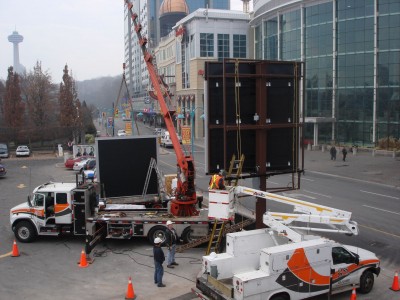Billboards and electrical safety
by Matthew | 19 February 2012 3:01 pm
 [1]
[1]By Les Stoch
Safety issues can arise when billboards and other signs are installed where nearby overhead electrical and communications lines pass horizontal to or above them. Signs installed too close to these lines can create hazards, not only for the installers themselves, but also for the signs’ owners, service professionals and maintenance staff, as well as the owners of the lines, which are most frequently electrical and communication utility providers.
Based on the operating voltage of these overhead lines, Canadian Standards Association (CSA) C.22.3 No. 1, Overhead Systems, Clause 4.7.3, Table 9 provides minimum horizontal and vertical clearances between utility lines and signs (see Figure 1) to avoid physical contact with electrical conductors. It is important to note conductor swing—due to prevalent weather conditions—must be added to all of the horizontal clearances. The degree of conductor swing is based on pole spans, line sags and whether the lines are considered sheltered or unsheltered.
To reduce the chance of electrical contact, utility providers take the utmost care to conform to their own construction standards. CSA’s clearances are normally adopted into these standards for most utilities, to help ensure their lines are not located too close to immovable objects, including but not limited to signs.
 [2]Pole-mounted overhead lines are often jointly used by electrical and communication utilities. Signs, especially billboards, are frequently installed after these lines are already in place, but when a sign is found too near a utility line—in violation of that utility’s standard for line clearances, as well as the CSA standard—it leaves the utility provider in a predicament as to what to do next.
[2]Pole-mounted overhead lines are often jointly used by electrical and communication utilities. Signs, especially billboards, are frequently installed after these lines are already in place, but when a sign is found too near a utility line—in violation of that utility’s standard for line clearances, as well as the CSA standard—it leaves the utility provider in a predicament as to what to do next.
Sometimes, the only viable choice is to remove the sign. Either the utility provider or the local electrical safety authority may request to have this done. Failure to deal with the situation is not an option.
In addition to CSA C.22.3 and utilities’ own standards, the 2009 Canadian Electrical Code—CSA C22.1—provides requirements in Rule 34-106(1) for the installation of signs in the vicinity of overhead electricity lines. The rule specifies signs must be located such that:
- people working on them are not likely to come into contact with overhead lines.
- no part of a sign or its support will interfere with normal work operations performed on electrical and communications lines, as defined by the utility; and
- no part of a sign or its support is in such proximity to overhead lines as to create a hazard.
It is easy to appreciate this rule identifies two distinct types of hazards concerning the proximity of signs to overhead lines, including:
- hazards to people installing or maintaining the signs; and
- hazards to utility personnel maintaining or making modifications to the overhead line systems.
Sign installers and maintenance personnel risking injury or death could also be in violation of provincial or territorial worker safety regulations. The danger to these professionals who risk contact with overhead lines is obvious. For unqualified personnel, meanwhile, the generally accepted limit of approach to electrical lines of up to 44 kV is 3.05 m (10 ft), as specified in CSA Z462-08, Workplace Electrical Safety, Table 1.
 [3]
[3]What may not be quite as obvious to sign installers is that electrical and communications utility providers use large, specialized equipment and very complex safety procedures when their employees work many feet above the ground. Should the location of a billboard or other sign interfere with properly setting up this equipment or it becomes impossible to carry out work on overhead lines according to the established safety procedures, the well-being of the utility personnel could also be put at risk.
By way of example, one sign installer in Toronto was replacing a billboard face using a special tool when its long metal handle came into contact with an electrical conductor. Accidents and near misses are unfortunately commonplace among people working on signs. Education is key, so installers will be aware of the law and minimum requirements.
Les Stoch is president of L. Stoch & Associates in Mississauga, Ont., which provides professional engineering services, including electrical engineering, professional development and training, quality management consulting and auditing. He is a member of Professional Engineers Ontario (PEO), the Ontario Electrical League (OEL) and the International Association of Electrical Inspectors (IAEI) and develops and teaches educational programs. For more information, visit www.lstoch.ca[4].
- [Image]: http://www.signmedia.ca/wp-content/uploads/2014/02/Vann-Media-Group_3.jpg
- [Image]: http://www.signmedia.ca/wp-content/uploads/2012/02/SM_Feb12_fig1_33.jpg
- [Image]: http://www.signmedia.ca/wp-content/uploads/2014/02/juggernaut.jpg
- www.lstoch.ca: http://www.lstoch.ca
Source URL: https://www.signmedia.ca/billboards-and-electrical-safety/